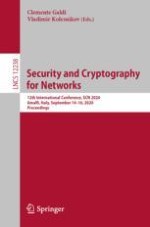2020 | Buch
Security and Cryptography for Networks
12th International Conference, SCN 2020, Amalfi, Italy, September 14–16, 2020, Proceedings
herausgegeben von: Clemente Galdi, Vladimir Kolesnikov
Verlag: Springer International Publishing
Buchreihe : Lecture Notes in Computer Science
